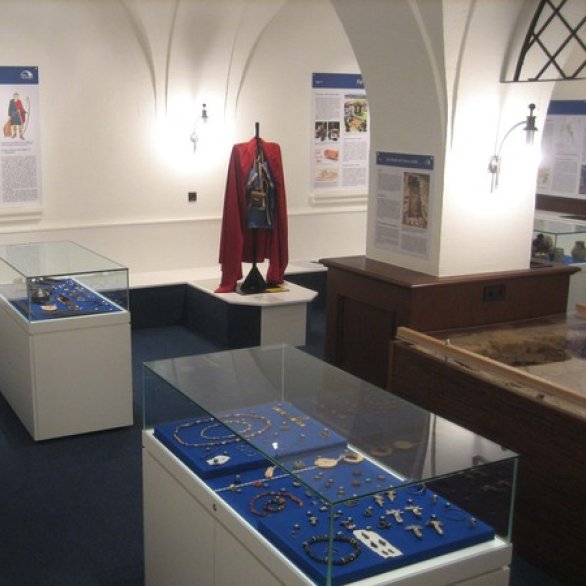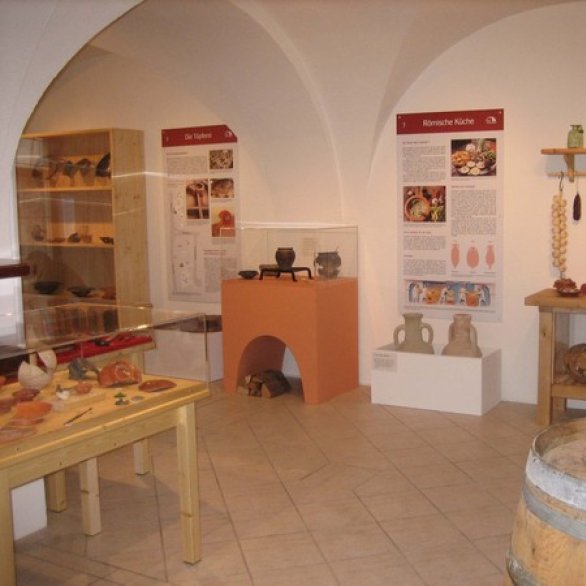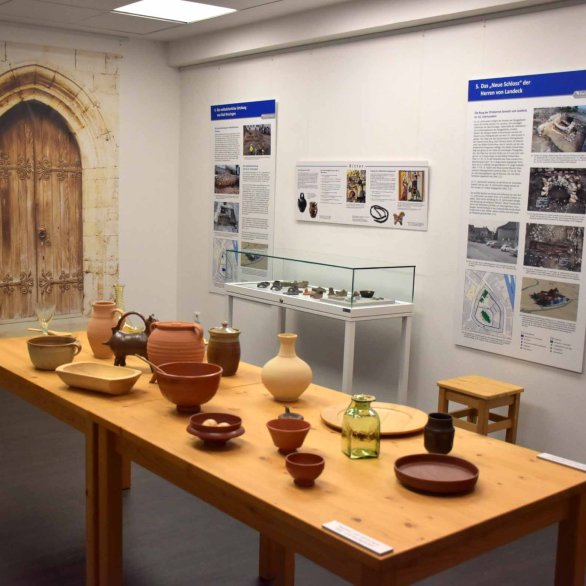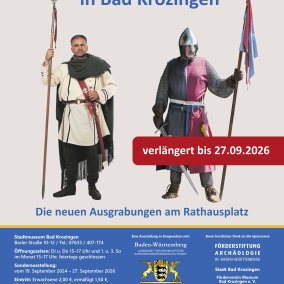The museum of local history in Bad Krozingen hosts numerous exhibits from the Roman past and the Romans' everyday lives. The finds mainly stem from excavations in a development area on the outskirts of the city from between 1971 to 1983. They prove that a Roman camp was once located right on the Roman road betweenBaselandMainzat around 70 AD.
The highlights of the exhibition are the finds from the Merovingian cemetery “Unterer Stollen” which were discovered by the Archäologischen Denkmalpflege Freiburg (Association for Monument Preservation Freiburg) in 1997/1998. Apparently Alemannic office holders from Franconialived next to the Roman road 500 AD. The findings of the excavations between 2001 and 2004 by the Freiburger Denkmalpflege at the Glöcklehofkappelle date back to the 7th and 12th century and exemplify life in an early medieval village. The new permanent exhibition is perfect for families and children who can play Roman games, learn how to write with Germanic runic characters and dress like ancient Romans or Alemanni.
The new exhibition focussing on the Stone Age and the celtic period shows the numerous archaeological findings of the area around Bad Krozingen. Some of them have never been seen before. Findings from settlements and extensive tomb adjuncts give an expression of the everyday life of the people living in this fertile region back then. The oldest evidence of human settlement are stone tools that were used by hunters and collectors, about 9000 years ago. The reconstructed burial chamber of a lady who had lived around 1100 BC is an outstanding highlight of this new department. In addition, the exhibition shoes tools, vessels and jewellery that was made by the celtic people.
On Sunday, 12th, 2013, 3 pm, the new department of the museum will be opened, that focuses on the lativian novelist Zenta Maurina. Zenta Maurina lived in Bad Krozingen from 1966 until her death in 1978 and is buried on the local graveyard. Her autobiographical scripts and her numerous essays are from special relevance.
Father Marqard Herrgott was a Benedictine monk, historian and minister at the court in Vienna and finally provost in Krozingen. After his studies in Freiburg and Strassburg he entered the Benedictine monastery St. Blasien. He was diplomatic deputy of the local classes at the imperial court in Vienna from 1728 to 1748. He started his extensive studies to the history of the house Habsburg, which were printed in glorious and sumptuous editions in the following decades. Concerning the contents, very thoroughly written, his works belonged to the standard works of south west german historical research until present. Despite the acknowledgement he received for his books, Herrgott made himself unpopular at the court in Vienna and was discplaced from the monastery to the parish in Krozingen in 1748, where he lived until his death. The parish (nowadays the castle) and the castle chapel took their today's shape due to reconstruction during his time in Krozingen.
This new exhibition will open on sunday, may 18th, 2014, 2 pm.
The highlights of the exhibition are the finds from the Merovingian cemetery “Unterer Stollen” which were discovered by the Archäologischen Denkmalpflege Freiburg (Association for Monument Preservation Freiburg) in 1997/1998. Apparently Alemannic office holders from Franconialived next to the Roman road 500 AD. The findings of the excavations between 2001 and 2004 by the Freiburger Denkmalpflege at the Glöcklehofkappelle date back to the 7th and 12th century and exemplify life in an early medieval village. The new permanent exhibition is perfect for families and children who can play Roman games, learn how to write with Germanic runic characters and dress like ancient Romans or Alemanni.
The new exhibition focussing on the Stone Age and the celtic period shows the numerous archaeological findings of the area around Bad Krozingen. Some of them have never been seen before. Findings from settlements and extensive tomb adjuncts give an expression of the everyday life of the people living in this fertile region back then. The oldest evidence of human settlement are stone tools that were used by hunters and collectors, about 9000 years ago. The reconstructed burial chamber of a lady who had lived around 1100 BC is an outstanding highlight of this new department. In addition, the exhibition shoes tools, vessels and jewellery that was made by the celtic people.
On Sunday, 12th, 2013, 3 pm, the new department of the museum will be opened, that focuses on the lativian novelist Zenta Maurina. Zenta Maurina lived in Bad Krozingen from 1966 until her death in 1978 and is buried on the local graveyard. Her autobiographical scripts and her numerous essays are from special relevance.
Father Marqard Herrgott was a Benedictine monk, historian and minister at the court in Vienna and finally provost in Krozingen. After his studies in Freiburg and Strassburg he entered the Benedictine monastery St. Blasien. He was diplomatic deputy of the local classes at the imperial court in Vienna from 1728 to 1748. He started his extensive studies to the history of the house Habsburg, which were printed in glorious and sumptuous editions in the following decades. Concerning the contents, very thoroughly written, his works belonged to the standard works of south west german historical research until present. Despite the acknowledgement he received for his books, Herrgott made himself unpopular at the court in Vienna and was discplaced from the monastery to the parish in Krozingen in 1748, where he lived until his death. The parish (nowadays the castle) and the castle chapel took their today's shape due to reconstruction during his time in Krozingen.
This new exhibition will open on sunday, may 18th, 2014, 2 pm.



